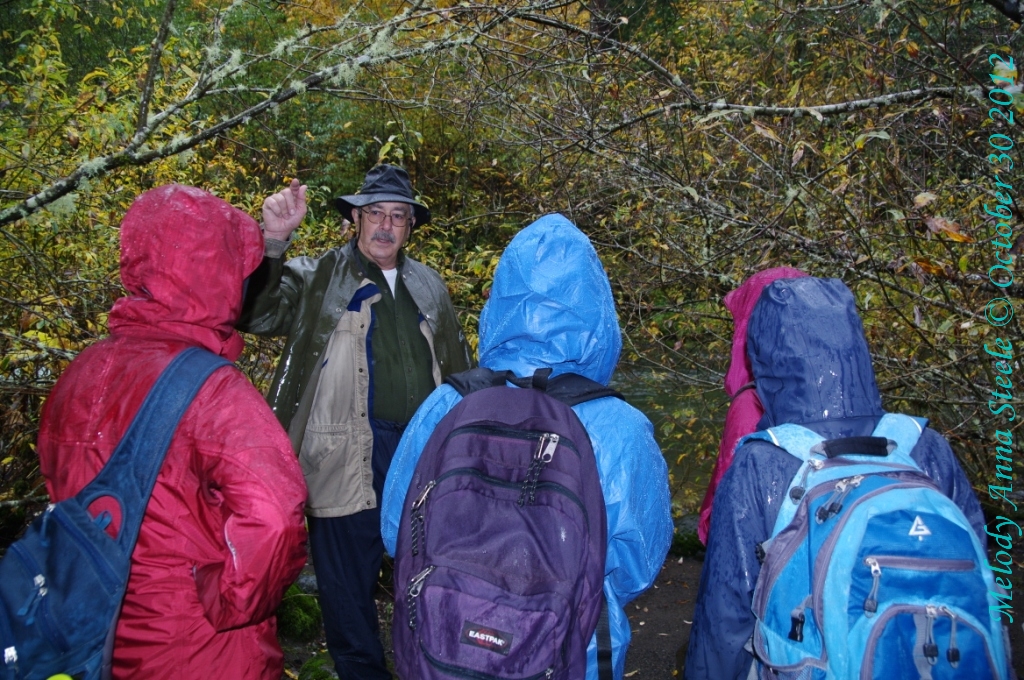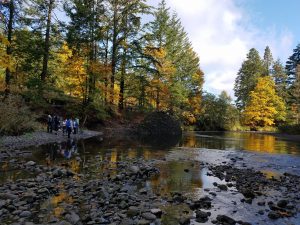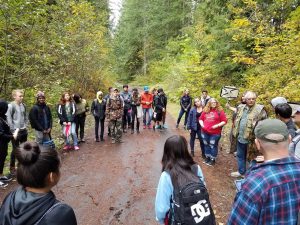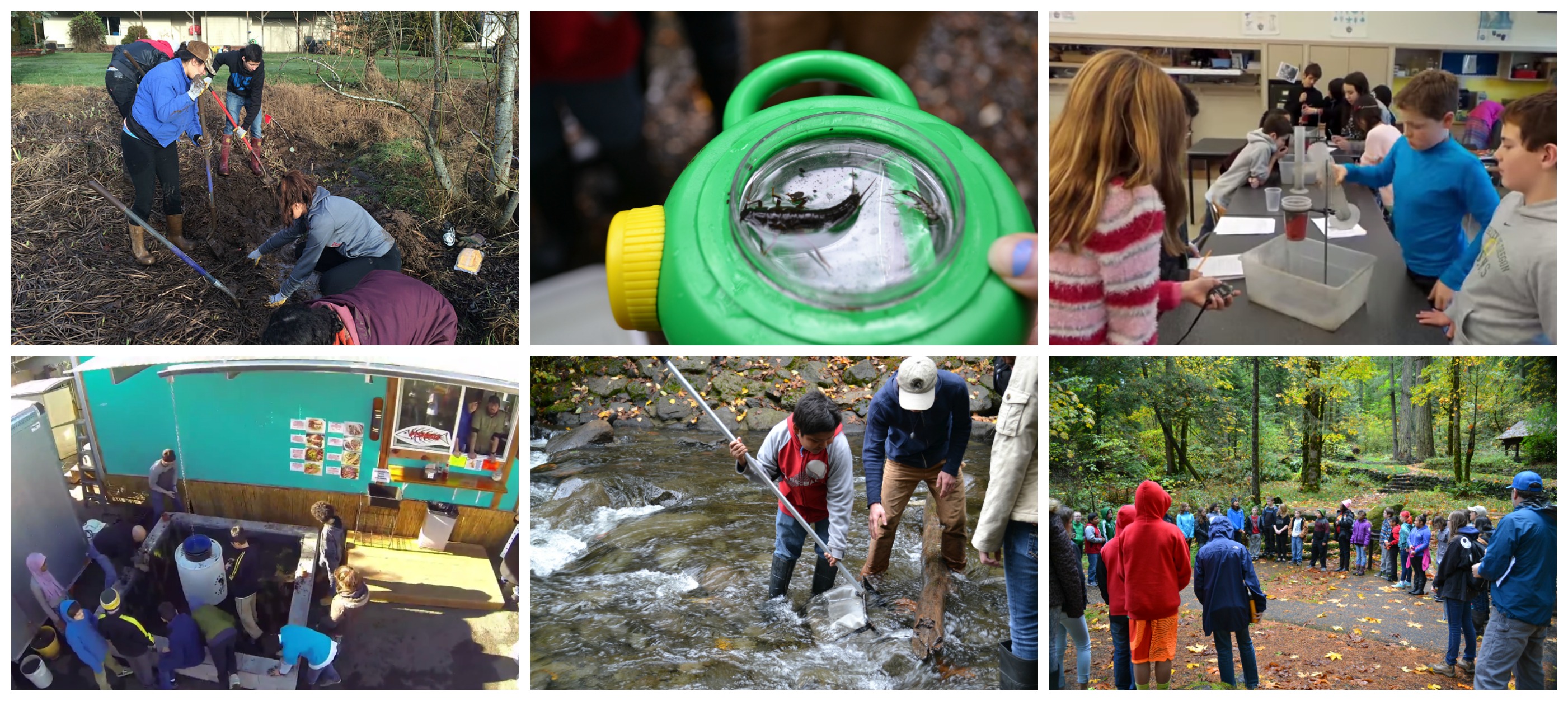Alex Whistler is a retired forester with the Bureau of Indian Affairs. In fall 2016, he was a star Salmon Watch Volunteer Educator, teaching on a total of six field trips in the Riparian Zone Observation field station.
Why did you first get involved in Salmon Watch?
I started participating in Salmon Watch because years ago, a mentor of mine thought it was important for folks with Native American heritage to get involved in our local communities. I’m a member of the Sac & Fox tribe and my mother was Choctaw. My mentor convinced me it was important to do something with education and kids.
Can you elaborate on why your mentor thought it was important to get involved in environmental education in particular?
Native youth living in urban environments and urban kids, period, just don’t get out in the woods enough. My mentor grew up on a reservation that was fortunate to have 4-H programs available. 4-H is a rural organization that has programs on forestry, bees, wildlife, soil, etc. He said his early involvement in 4-H was enlightening because once you learn the science behind what’s going on in the soil or why bees are important, then you might want to come back to that field for a career. Kids need to know their options. They need to know there are more options available than playing basketball or being a rock star.
Why is it important that kids get exposure to nature and science early in life?
Why do you give kids dinosaur toys to play with? If they play with dinosaur toys, some of them become interested in paleontology. If you give them a chemistry set, they might become interested in chemistry and go on to become a chemist. Once you start someone down a path of interest in science, they might continue it for the rest of their lives.
And the other part of it is, I think it’s extremely good for kids to be in the woods. Kids need to be outside of a controlled environment with mowed grass, paved paths, and planted trees. You’re free in the woods, and the things around you aren’t artificial.
What is your favorite thing about volunteering with Salmon Watch?
I teach the Riparian Observation field trip station, and my favorite thing is watching the kids make the connection between what’s going on in the forest and what’s going on in the river. There’s a lot happening on any given stream bank.
As a Salmon Watch volunteer, you have 40 minutes to teach a group of kids how much is going on right where you’re standing. And there’s so much going on with the other field stations related to the stream’s hydrology and the surrounding vegetation in the riparian area.
There’s so much going on and you can miss all of it if you just walk through without paying attention.
Do you think Salmon Watch helps inspire an environmental ethic in students?
I think it does. In the Salmon Biology station, the fish biologist will talk about what the fish need. The Water Quality station volunteer will talk about the water conditions needed for the health of the fish.
And if the kids remember only 30 percent of that, they’ll know the water has to be clean, cold, and clear. And in the Riparian station they’ll learn that we keep the water clean by preserving the forest and streamside vegetation. So, the environmental protection point is driven home in all of the field trip stations.
Environmental changes affect our lives. And unless you learn about how these changes are affecting the world around you, you don’t think it makes much difference. And it’s going to be their world, not ours. Older folks will see this through without too much difficulty, but our kids are gonna be stuck with it.
Does being outside and seeing and touching their natural environment help students better retain what they are learning?
You can teach kids a lot of things in a classroom, and the information just doesn’t come together until you see it on the ground. You can learn about Mount St. Helens ash in a classroom. You can read the volumes written about it.
But until you go out into the woods today, 37 years later, and stick a shovel in the ground and throw the spade over, and there’s this absolutely stunning band across the soil structure, and you go, “Oh! That’s Mt. St. Helens ash from 1980!” When you see that, it sticks with you. You can learn it in the classroom, but when you see it in the field, it’s real.
Why should others volunteer with Salmon Watch?
Because once you get over the nervousness it’s fun. When I first start each year, I’m worried about whether I know enough. I’m worried about whether I’ll do a good job presenting the things I know. I’m worried about whether the site will demonstrate things I’m capable of talking about.
But by now, I’ve done it enough times that I know that there are always things to talk about. There are always things going on that will interest the kids. So, why should people do it? Because it’s fun. I don’t play golf, but it’s cheaper than playing golf for the day, and it gets you out of the house (laughs). It gets you outside, into a beautiful place with a purpose. And you have a sense of accomplishment when you’re done.
Sign up to be a Salmon Watch Volunteer Educator today!
https://worldsalmoncouncil.org/our-programs/2017-18-volunteer-application/






Recent Comments